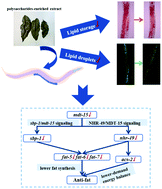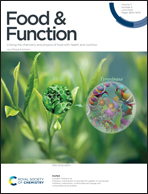Anti-fat effect and mechanism of polysaccharide-enriched extract from Cyclocarya paliurus (Batal.) Iljinskaja in Caenorhabditis elegans†
Abstract
Obesity is a global epidemic. Recent studies have shown that Cyclocarya paliurus (C. paliurus) leaves have the potential to alleviate fat deposits. However, the fat-reducing mechanism of it remains unclear. Using Caenorhabditis elegans (C. elegans) as a model, we found that C. paliurus polysaccharide (CPP) significantly decreased fat storage in both normal and high-fat worms without affecting the movement. Moreover, the size and number of lipid droplets were reduced in CPP-treated ZXW618 worms. In energy metabolism, CPP decreased Escherichia coli (E. coli) OP50 growth and pharyngeal pumping and increased the expression of vit-2. In lipid metabolism, CPP down-regulated the expression of the sbp-1 and nhr-49 genes by modulating mdt-15 to prevent the expression of the Δ9-desaturase genes (fat-5, fat-6 and fat-7). Meanwhile, the expression of the acs-2 genes, the downstream of nhr-49, was suppressed by CPP. These findings provided insights into the CPP-induced anti-fat mechanisms, which contributed to the application of CPP in anti-obesity drugs.



 Please wait while we load your content...
Please wait while we load your content...